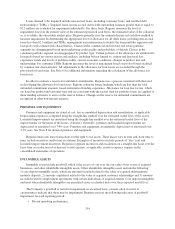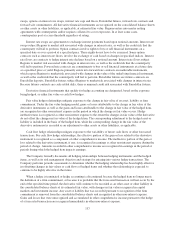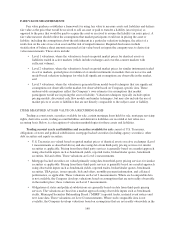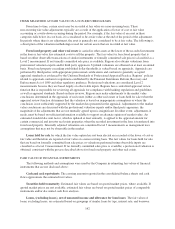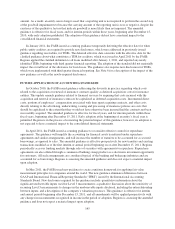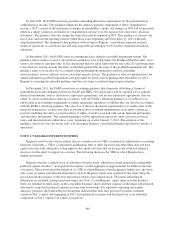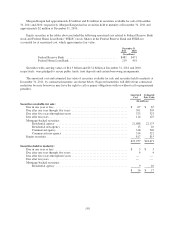Regions Bank 2011 Annual Report Download - page 166
Download and view the complete annual report
Please find page 166 of the 2011 Regions Bank annual report below. You can navigate through the pages in the report by either clicking on the pages listed below, or by using the keyword search tool below to find specific information within the annual report.ITEMS MEASURED AT FAIR VALUE ON A NON-RECURRING BASIS
From time to time, certain assets may be recorded at fair value on a non-recurring basis. These
non-recurring fair value adjustments typically are a result of the application of lower of cost or fair value
accounting or a write-down occurring during the period. For example, if the fair value of an asset in these
categories falls below its cost basis, it is considered to be at fair value at the end of the period of the adjustment.
In periods where there is no adjustment, the asset is generally not considered to be at fair value. The following is
a description of the valuation methodologies used for certain assets that are recorded at fair value.
Foreclosed property and other real estate is carried in other assets at the lower of the recorded investment
in the loan or fair value less estimated costs to sell the property. The fair value for foreclosed property that is
based on either observable transactions of similar instruments or formally committed sale prices is classified as a
Level 2 measurement. If no formally committed sale price is available, Regions also obtains valuations from
professional valuation experts and/or third party appraisers. Updated valuations are obtained on at least an annual
basis. Foreclosed property exceeding established dollar thresholds is valued based on appraisals. Appraisals are
performed by third-parties with appropriate professional certifications and conform to generally accepted
appraisal standards as evidenced by the Uniform Standards of Professional Appraisal Practice. Regions’ policies
related to appraisals conform to regulations established by the Financial Institutions Reform, Recovery and
Enforcement Act of 1989 and other regulatory guidance. Professional valuations are considered Level 2
measurements because they are based largely on observable inputs. Regions has a centralized appraisal review
function that is responsible for reviewing all appraisals for compliance with banking regulations and guidelines
as well as appraisal standards. Based on these reviews, Regions may make adjustments to the market value
conclusions determined in the appraisals of real estate (either as other real estate or loans held for sale) when the
appraisal review function determines that the valuation is based on inappropriate assumptions or where the
conclusion is not sufficiently supported by the market data presented in the appraisal. Adjustments to the market
value conclusions are discussed with the professional valuation experts and/or third party appraisers; the
magnitude of the adjustments that are not mutually agreed upon is insignificant. In either event, adjustments, if
made, must be based on sufficient information available to support an alternate opinion of market value. An
estimated standard discount factor, which is updated at least annually, is applied to the appraisal amount for
certain commercial and investor real estate properties when the recorded investment in the loan is transferred into
foreclosed property. Internally adjusted valuations are considered Level 3 measurements as management uses
assumptions that may not be observable in the market.
Loans held for sale for which the fair value option has not been elected are recorded at the lower of cost or
fair value and therefore are reported at fair value on a non-recurring basis. The fair values for loans held for sale
that are based on formally committed loan sale prices or valuations performed using observable inputs are
classified as a Level 2 measurement. If no formally committed sales price is available, a professional valuation is
obtained, consistent with the process described above for foreclosed property and other real estate.
FAIR VALUE OF FINANCIAL INSTRUMENTS
The following methods and assumptions were used by the Company in estimating fair values of financial
instruments that are not disclosed above:
Cash and cash equivalents: The carrying amounts reported in the consolidated balance sheets and cash
flows approximate the estimated fair values.
Securities held to maturity: Estimated fair values are based on quoted market prices, where available. If
quoted market prices are not available, estimated fair values are based on quoted market prices of comparable
instruments and/or discounted cash flow analyses.
Loans, (excluding leases), net of unearned income and allowance for loan losses: The fair values of
loans, excluding leases, are estimated based on groupings of similar loans by type, interest rate, and borrower
142




